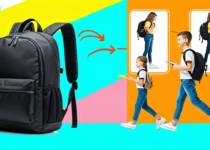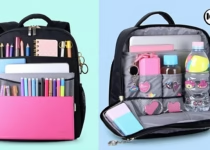Cycling Backpacks with Helmet Holders: Are They Worth It?

Choosing Cycling Backpacks
Selecting the right cycling backpack is essential for a comfortable and efficient ride. With various options available, there are key factors to consider to ensure the backpack meets your needs.
Factors to Consider
When looking for a biking backpack, several important aspects must be taken into account:
- Comfort: The backpack should fit well and not hinder mobility while riding. Look for wide, padded straps that distribute weight evenly across the shoulders.
- Waterproofing: Consider a waterproof design or materials that can withstand light rain. This is especially important for commuters and mountain bikers who may encounter wet conditions.
- Visibility Features: Reflective strips or bright colors enhance visibility to ensure safety during low-light conditions. This is crucial for urban cyclists.
- Ventilation: Good airflow in the back panel helps reduce sweat buildup. Adequate ventilation is especially beneficial for longer rides, allowing for greater comfort.
For more information on choosing an ergonomic option, check out how to choose an ergonomic cycling backpack for comfort and posture.
Size and Capacity
The size of the backpack plays a major role in its functionality. Cycling backpacks generally offer between 20 and 30 liters of storage capacity, which provides a suitable balance between weight and storage for commuting needs.
| Capacity | Suitable For |
|---|---|
| 20L | Short commutes or light riding |
| 25L | Daily commuting with extra gear |
| 30L | Longer rides or those needing hydration systems |
A well-sized backpack should be big enough to fit all necessary items, such as tools, snacks, or even a laptop, without feeling cumbersome. Cyclists can opt for hydration-compatible designs, especially during longer rides; these typically include integrated hydration systems for easy access to water (hydration-compatible cycling backpacks: what to look for).
Considering these factors will ensure that cyclists choose a backpack that enhances their biking experience while providing comfort and convenience on every ride.
Top Cycling Backpacks
When considering the best cycling backpacks with helmet holders, several options stand out due to their functionality, comfort, and design. Below are four highly recommended cycling backpacks suitable for various cycling activities.
Chrome Barrage
The Chrome Barrage is known for its waterproof design, making it a top pick for general use. It offers versatile storage options and meets cabin luggage dimensions for most airlines, allowing for easy travel. This backpack is ideal for cyclists who also need a reliable bag for daily commutes or weekend trips.
Key Features:
- Waterproof material
- Multiple compartments for organization
- Fits cabin luggage dimensions
| Feature | Specification |
|---|---|
| Capacity | Approximately 25L |
| Weight | 1.5 lbs (680 g) |
For more information on features, explore our guide on how to choose an ergonomic cycling backpack for comfort and posture.
Ortlieb Commuter Daypack
The Ortlieb Commuter Daypack is praised for its durability and functions as a dry bag. It includes a large main compartment, removable inserts for organization, and external loops for mounting lighting systems. This design is especially useful for commuters who require added visibility and organization.
Key Features:
- Dry bag construction
- Removable organizers
- External lighting mounting options
| Feature | Specification |
|---|---|
| Capacity | 20L |
| Weight | 2.2 lbs (1000 g) |
For additional insights on practical design elements, check out our article on why a ventilated back panel matters in a cycling backpack.
Patagonia Black Hole
The Patagonia Black Hole backpack is ideal for general use and travel. Boasting a generous 32L capacity, it features a comfortable design and a laptop compartment accessible from the rear panel, offering added security for your electronics.
Key Features:
- 32L capacity
- Rear-access laptop compartment
- Durable and weather-resistant materials
| Feature | Specification |
|---|---|
| Weight | 1.5 lbs (680 g) |
| Dimensions | 20 x 12 x 10 inches (51 x 30 x 25 cm) |
To learn about hydration options, check our insights on hydration-compatible cycling backpacks: what to look for.
Provis Reflect360
The Provis Reflect360 is designed for increased visibility during low light or night cycling thanks to its strong reflective material. This backpack prioritizes safety, making it an excellent choice for cyclists who often ride in the early morning or late evening.
Key Features:
- High visibility reflective material
- Weather-resistant fabric
- Functional design with multiple pockets
| Feature | Specification |
|---|---|
| Capacity | 25L |
| Weight | 1.1 lbs (500 g) |
For more information on safety features, read our article on reflective features that improve cycling visibility.
These top cycling backpacks provide options for various cycling needs, from commuting to weekend adventures. Whether it’s protection from weather, organization, or visibility, each backpack brings something special to enhance the cycling experience.
More Recommended Backpacks
Here are some additional cycling backpacks that are highly recommended for any cyclist looking for the right balance between functionality and comfort.
Ortlieb Messenger
The Ortlieb Messenger is well-known for its large capacity and waterproof design. It excels in carrying heavy loads comfortably, making it a great choice for urban cyclists who need to transport various items. This bag features a simple design with an unorganized main compartment, which may lack internal organization pockets or laptop sleeves. However, its strength lies in functionality; this backpack can keep your belongings dry during unexpected rain showers.
| Feature | Description |
|---|---|
| Capacity | Large |
| Design | Waterproof |
| Organization | Minimal internal organization |
| Comfort | Excellent load-carrying capabilities |
Chrome Kadet
The Chrome Kadet is a lightweight sling-style bag tailored for quick jaunts into town. Ideal for carrying essentials like a camera or an extra layer, it’s designed to be efficient and compact. Notably, it features a D-lock holster, providing a convenient place to carry your bike lock comfortably.
| Feature | Description |
|---|---|
| Style | Sling |
| Weight | Lightweight |
| Special Feature | D-lock holster for easy lock carrying |
| Ideal For | Short trips |
Camelbak HAWG Commute 30L
The Camelbak HAWG Commute 30L is designed with a focus on organization. It offers multiple pockets for storing and safeguarding items, a weatherproof sleeve for extra protection, and additional space for a bike lock or water bottle. This pack is perfect for those who prefer having all their gear well-arranged and ready for business.
| Feature | Description |
|---|---|
| Capacity | 30L |
| Organization | Well-thought-out pockets |
| Weatherproof | Includes a waterproof sleeve |
| Versatile | Space for both bike locks and bottles |
Deuter Amager 25+5
The Deuter Amager 25+5 is known for its durability, construction quality, and comfort. This backpack is designed to meet the needs of cyclists with its practical features and structural integrity. The adjustable volume (25+5) allows cyclists to expand capacity as needed while remaining stylish and functional.
| Feature | Description |
|---|---|
| Capacity | Adjustable (25+5) |
| Construction | High-quality and durable |
| Comfort | Comfortable fit for prolonged use |
| Design | Functional and stylish |
Choosing the right backpack is crucial for enhancing the cycling experience. When looking into various options, consider how each one fits your specific needs, whether for commuting or adventurous riding. Always remember to check out how to choose an ergonomic cycling backpack for comfort and posture for tips on comfort and safety.
Helmet Attachment Systems
When it comes to cycling backpacks with helmet holders, understanding the helmet attachment systems is essential. These systems can vary widely in terms of features and mechanisms.
Helmet Holder Features
The primary function of helmet holders in cycling backpacks is to conveniently secure the helmet when not in use. Various features enhance usability and functionality:
| Feature | Description |
|---|---|
| Adjustability | Allows customization to fit different helmet styles and sizes securely. |
| Accessibility | Quick access points ensure riders can easily attach or detach their helmets as needed. |
| Storage Options | Some backpacks offer additional pockets for storing small items or accessories alongside the helmet. |
| Stability | Designed to keep the helmet in place during rides, preventing unnecessary movement. |
Features such as adjustability and accessibility increase the convenience of using a backpack while biking, allowing cyclists to focus on their ride rather than their equipment.
Attachment Mechanisms
The way helmets are attached to backpacks varies, and understanding these mechanisms can help cyclists make informed choices:
| Mechanism | Description |
|---|---|
| Straps | Adjustable straps that securely hold the helmet in place, often with quick-release buckles for easy use. |
| Cargo Nets | Stretchy nets that can accommodate various helmet sizes, providing a flexible solution for different helmet designs. |
| Clip Systems | Dedicated clips designed to latch onto helmet straps, providing a stable attachment without bulky materials. |
Choosing the right attachment mechanism is vital for ensuring that the helmet is secured during rides. Riders can also refer to our guide on why backpacks with cargo nets are useful for cyclists for more insights.
Overall, the features and mechanisms involved in helmet attachment systems play a critical role in the practicality of cycling backpacks. With well-designed attachments, cyclists can feel more secure knowing their helmet is safely stored while they ride.
Backpack Benefits for Mountain Bikers
Mountain biking is an exhilarating activity that requires proper gear to enhance performance and safety. One essential piece of equipment for mountain bikers is a well-designed backpack. Cycling backpacks not only offer hydration options but also help riders stay organized on their adventures.
Stay Hydrated and Organized
Staying hydrated is crucial for mountain bikers during long rides. Many cycling backpacks come equipped with integrated hydration systems, such as water reservoirs (bladders) and drinking tubes, which allow riders to sip water hands-free without stopping. This feature ensures that hydration is quick and efficient, especially during intense or lengthy rides.
In addition to the hydration systems, mountain bike backpacks provide ample storage for other essential gear. They typically include compartments for tools, spare tubes, pumps, snacks, first aid kits, and even protective gear like knee or elbow pads. This organized setup allows bikers to access items quickly without rummaging through their bags, thus maintaining focus on the ride.
| Backpack Feature | Details |
|---|---|
| Hydration System | Integrated bladders and drinking tubes for hands-free access |
| Storage | Multiple compartments for organizing tools, snacks, and more |
| Efficiency | Quick access to critical items without stopping |
Stable Design for Trail Riding
Mountain bike backpacks are specifically engineered to remain close to the rider’s body, significantly reducing the potential for movement during bumpy rides. They often feature adjustable, padded shoulder straps, chest straps, and narrow hip belts, which distribute weight evenly across the body. This ergonomic design minimizes fatigue and prevents distractions, enabling bikers to concentrate on the trail ahead.
Proper stability is key when navigating challenging terrains. A well-fitted backpack allows for agile movements without the nagging feeling of loose gear. Bikers can then tackle steep hills, sharp turns, and rough paths with more confidence, knowing their gear is secure.
For more tips on selecting the right features, check out our guide on how to choose an ergonomic cycling backpack for comfort and posture, and learn why having a ventilated back panel is essential in our article on why a ventilated back panel matters in a cycling backpack.
Features of Mountain Bike Backpacks
Tool Storage and Accessibility
Mountain bike backpacks are specifically designed to provide convenient storage for essential gear beyond just hydration. They typically come equipped with multiple compartments and pockets that are perfect for organizing items like tools for repairs, spare tubes, pumps, snacks, first aid kits, and sometimes protective gear, such as knee or elbow pads. Efficient organization ensures that cyclists can quickly access their gear when needed.
| Item Type | Storage Features |
|---|---|
| Tools | Dedicated tool pockets |
| Hydration | Hydration reservoir compartment |
| Snacks | Easy-access compartments for quick snacks |
| First Aid Kits | Specialized pocket with easy access |
| Protective Gear | Secure storage for knee/elbow pads |
Secure Fit and Weight Distribution
A secure fit and proper weight distribution are crucial for comfort during long rides. Mountain bike backpacks should ideally feature adjustable straps that help stabilize the pack on the rider’s back, reducing movement while cycling. This can prevent discomfort and help maintain balance.
Additionally, some backpacks come with sternum and waist straps to improve stability. These features not only enhance comfort but also allow for better weight distribution, enabling cyclists to carry their gear without straining their backs or shoulders. For more on how these straps can help, check out our article on how sternum and waist straps improve stability on the bike.
| Feature | Benefits |
|---|---|
| Adjustable Straps | Custom fit to reduce pack movement |
| Sternum Straps | Enhances stability and reduces bounce |
| Waist Straps | Better weight distribution and comfort |
These features make mountain bike backpacks a practical choice, ensuring cyclists can efficiently carry their gear while maintaining comfort and stability during their rides. For more tips on choosing the right cycling backpack, visit our article on how to choose an ergonomic cycling backpack for comfort and posture.
Comfort and Ventilation
Comfort and ventilation are key components to consider when selecting the right cycling backpack, especially for those tackling longer rides or challenging trails. A well-ventilated backpack not only enhances comfort but also helps in managing heat and moisture effectively.
Breathable Back Panels
Mountain bike backpacks often incorporate breathable back panels designed with air channels or mesh padding. These features promote ventilation, reducing moisture buildup and keeping cyclists cooler during hot summer rides. Good airflow is essential for comfort as it helps dissipate heat generated during vigorous activities like cycling on challenging trails. For more information on why having a ventilated back panel matters, check out our article on why a ventilated back panel matters in a cycling backpack.
| Feature | Benefits |
|---|---|
| Air Channels | Enhances airflow and reduces sweat |
| Mesh Padding | Provides comfort while allowing ventilation |
| Moisture Management | Keeps the back dry and comfortable under stress |
Ergonomic Design
An ergonomic design is another vital aspect of cycling backpacks. An ergonomically designed backpack fits the natural shape of the body, allowing for better posture and distributing weight evenly. This design reduces shoulder strain and back discomfort during long rides. To ensure maximum comfort and posture support, it’s recommended to look for features that cater to ergonomic needs, such as adjustable straps and sternum supports. For tips on choosing an ergonomic cycling backpack, refer to our guide on how to choose an ergonomic cycling backpack for comfort and posture.
| Design Feature | Benefits |
|---|---|
| Adjustable Straps | Ensures a snug fit and reduces bouncing |
| Sternum Support | Provides additional stability during rides |
| Weight Distribution | Minimizes fatigue and enhances comfort |
By prioritizing breathable back panels and ergonomic designs, cyclists can greatly enhance their riding experience. This ensures that activities like commuting or trail riding remain enjoyable and comfortable.
Durability and Safety
When selecting a cycling backpack, durability and safety are paramount, especially for those who frequently tackle rough terrains. Mountain bike backpacks are designed with features that enhance their longevity and protect the rider.
Abrasion-Resistant Materials
Backpacks meant for mountain biking are constructed from robust, abrasion-resistant materials. These fabrics withstand harsh conditions and rough handling, ensuring that the backpack can endure bumps, scrapes, and other elements faced during rides. This is crucial for cyclists who frequently ride on rocky or uneven trails, as durability directly impacts the lifespan of the backpack.
In addition, the durable materials help to keep the contents safe from potential damage during unexpected spills or falls. Riders can feel assured that their gear is protected, enabling them to focus on the ride without worrying about wear and tear on their equipment. For a deeper understanding of choosing the right materials, check our guide on the best materials for breathability in cycling backpacks.
| Material Type | Properties |
|---|---|
| Nylon | Lightweight, durable, water-resistant |
| Polyester | Strong, abrasion-resistant, quick-drying |
| Cordura | Highly resistant to abrasions, tears, and scuffs |
Integrated Back Protectors
Many mountain bike backpacks come with integrated back protectors, enhancing rider safety during rides. These protectors are designed to absorb impact and minimize injury risks in case of falls or collisions. By evenly distributing pressure across the back, integrated protectors help stabilize the body’s structure, providing a reassuring level of safety for the cyclist.
This added feature is particularly beneficial for individuals navigating challenging trails, where unexpected accidents can occur. Riders can enjoy their ride with greater confidence, knowing that they have additional protection. For tips on how to enhance stability while riding, refer to our article on how sternum and waist straps improve stability on the bike.
In summary, durability and safety are critical features of cycling backpacks, especially those intended for mountain biking. With abrasion-resistant materials and integrated back protectors, cyclists can focus on their adventures, knowing they have reliable and secure gear by their side.


